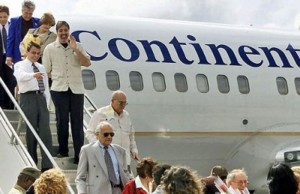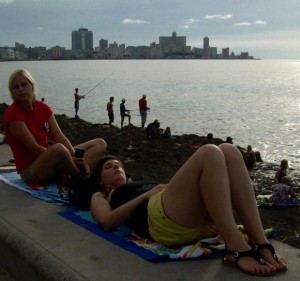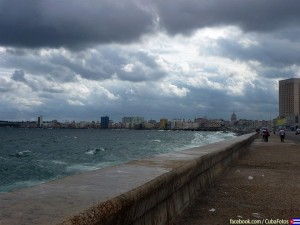(2014) EN SEIS MESES 327 MIL PASAJEROS VIAJARON A CUBA DESDE EEUU.

El número de viajeros de Estados Unidos a Cuba sigue creciendo en espiral y experimentó un crecimento de un 10% en el primer semestre del año con relación al 2013.
Al cierre de junio, el flujo de viajeros desde Estados Unidos mostró un crecimiento de un 9.9 % en comparación con igual período del año anterior, lo que significa la cifra más alta para un semestre con un total de 327,600. El incremento fue de 29,525 pasajeros con respecto al 2013, de acuerdo con un estudio de The Havana Consulting Group (THCG).
Las estadísticas registradas muestran que Estados Unidos se consolida cada vez más como el segundo emisor de turistas a Cuba, después de Canadá, que sumó 736,845 visitantes a la isla entre enero y junio.
Del total de pasajeros con destino a Cuba, el 90.7% viajó desde Miami, mientras que el 9.3% lo hizo desde Tampa. En total se produjeron 2,184 vuelos desde ambos aeropuertos a siete destinos en la isla.
Con un total de 327,600 viajeros.
El mes de enero alcanzó la mayor cantidad de vuelos desde el aeropuerto de Miami con 423, mientras que desde el aeropuerto de Tampa el mayor volumen se produjo en abril, con 39 vuelos. Sumados ambos orígenes, el pico de vuelos ocurrió en enero con 460, y junio resultó el de menor afluencia con 340, unos 120 vuelos menos.
El semestre tuvo un promedio conjunto de 77.55 vuelos semanales desde los aeropuertos de Miami (73.5%) y Tampa (5.05%). El promedio diario de pasajeros fue de 1,810.
Enero fue también el mes con el más alto flujo de pasajeros, con 69,000 y febrero el de menor volumen, con 49,050. El promedio mensual de pasajeros a la isla fue de 54,600.
Norteamérica a la cabeza
Norteamérica supera en casi cuatro veces a Europa como emisor turístico a Cuba.
Los números compilados por THCG y el reporte divulgado esta semana por la Oficina Nacional de Estadísticas e Información (ONE), reflejan una realidad irrebatible: el invierno canadiense y la emigración cubana en funciones de turismo familiar son actualmente los principales motores de la industria turística de la isla. Las estadísticas oficiales cubanas obvian la cantidad de pasajeros por viajes familiares procedentes de EEUU.
Actualmente existen tres grupos fundamentales en los que se concentran los principales emisores de turistas a Cuba: Canadá, Estados Unidos y cinco emisores de Europa (Inglaterra, Alemana, Francia, Italia y España.
Con un total de 286,511 viajeros.
Si comparamos el crecimiento de estos tres grupos de emisores de turismo, Estados Unidos fue el de mayor crecimiento en la primera mitad de año, superior en cinco puntos porcentuales al de Canadá, que subió un 4.3% y el del quintero de los principales emisores europeos, que apenas creció un 3.8%.
Entre Canadá y Estados Unidos suman un total de 1,064,445 turistas, por solo 286,511 turistas provenientes de los cinco principales emisores europeos. La relación es de 78.8% EEUU-Canadá por 21.2% los cinco grandes emisores europeos.
Aunque el Ministerio del Turismo cubano (MINTUR) no lo reporta en sus estadísticas, son justamente los viajeros de Norteamérica los que han determinado el discreto aumento de las ganancias del sector, calculadas en $1,077 millones de dólares, casi un 60% de la recaudación total al cierre del 2013,
Esta desbalanceada correlación de ambos bloques está sentando las bases para un inevitable cambio del actual producto turístico cubano, que tiene la mayoría de su oferta orientada al todo incluido de sol y playa.
Tentaciones de Marina Gaviota
Justamente para el próximo año debe concluir la expansión de Marina Gaviota en Varadero, con el propósito de facilitar el acceso de gtandes embarcaciones de recreo. Después de la renovación y ampliación, la Marina Gaviota Varadero se convertirá en la mayor y más moderna de Cuba, con capacidad para el atraque de 1, 200 embarcaciones.
Por eso la industria turística cubana -dependiente casi en un 90% del turismo de sol y playa- está abocada un cambio estratégico en el diseño de su oferta. Con vistas a esa transformación esencial se ha concebido el desarrollo de cinco megaproyectos multimillonarios que podrían cambiar definitivamente el producto turístico: 1. Construcción de resorts de lujos asociados a campos de golf en zonas de playas y exuberante belleza natural, 2. Construcción de la megamarina Gaviota de Varadero, 3. Conversión del puerto de La Habana en el enclave turístico más importante de la capital y centro principal de recepción de cruceros en el país, 4. Expansión de un poderoso enclave hotelero en los cayos al norte de Villa Clara y 5. Ampliación de las inversiones en Varadero.
Se trata de un cambio de mentalidad en cómo enfocar el negocio y atraer a los inversionistas, en aras de crear un mejor producto turístico. De lo de lo contrario, la industria turística cubana continuará a la zaga de los destinos más populares y atractivos de la región, dominada por las ofertas del Caribe mexicano, República Dominicana y Bahamas.
CafeFuerte/Emilio Morales/Excerpts/InternetPhotos/www.thecubanhistory.com
The Cuban History, Hollywood.
Arnoldo Varona, Editor.
(2014) IN SIX MONTHS 327 THOUSAND PASSENGERS TRAVELED FROM EEUU TO CUBA.
The number of travelers from the United States to Cuba continues to grow spirally crecimento experienced a 10% in the first half of the year compared to 2013.
At end-June, the flow of travelers from the United States showed an increase of 9.9% compared to the same period last year, which means the highest figure for a semester with a total of 327,600. The increase was 29,525 passengers compared to 2013, according to a study by The Havana Consulting Group (THCG).
The recorded statistics show that the United States continues to grow stronger as the second source of tourists to Cuba after Canada, which totaled 736.845 visitors to the island between January and June.
Of the total passengers traveling to Cuba, 90.7% traveled from Miami, while 9.3% did so from Tampa. In total there were 2,184 flights from both airports to seven destinations in the island.
With a total of 327,600 passengers.
January reached the highest number of flights from the airport in Miami with 423, while from the Tampa airport the highest volume occurred in April, with 39 flights. Together both sources, the peak flight occurred in January 460, and June was the 340-peak, about 120 fewer flights.
The semester had an average of 77.55 set weekly flights from airports in Miami (73.5%) and Tampa (5.05%). The daily average was 1,810 passengers.
January was also the month with the highest passenger flow, with 69,000 and February the lowest volume, with 49,050. The monthly average number of passengers to the island was 54,600.
America ahead.
North America than in Europe almost four times as a tourist to Cuba issuer.
The numbers compiled by THCG and report released this week by the National Bureau of Statistics and Information (ONE) reflect an irrefutable fact: the Canadian winter and Cuban emigration family tourism functions are currently the main drivers of the tourism industry the island. Cuban official statistics obviate the number of passengers per family travel from the USA.
There are currently three main groups in which the major sources of tourists to Cuba are concentrated: Canada, United States and five issuers of Europe (England, Germany, France, Italy and Spain.
With a total of 286.511 passengers.
If we compare the growth of these three groups of issuers tourism, America was the fastest growing in the first half of the year, up five percentage points to Canada, which rose 4.3% and the major European quintero issuers , which grew just 3.8%.
Between Canada and the United States totaling 1,064,445 tourists for only 286.511 tourists from five major European issuers. The ratio is 78.8% USA-Canada 21.2% for the five major European issuers.
Although the Cuban Ministry of Tourism (MINTUR) do not report their statistics are just travelers in North America who have given the slight increase in industry profits, estimated at $ 1.077 billion, almost 60% of total revenue at the end of 2013,
This unbalanced correlation of both blocks is setting the stage for an inevitable change in the current Cuban tourist product, which has most of its oriented all inclusive sun and sand supply.
Temptations of Marina Gaviota
Just for next year must complete the expansion of Marina Gaviota Varadero, in order to facilitate access gtandes boats. After the renovation and expansion, the Marina Gaviota Varadero will become the largest and most modern of Cuba, with berthing capacity for 1, 200 vessels.
So the Cuban tourism industry -dependent almost 90% of the sun-and is bound beach- a strategic shift in the design of their offer. Overlooking this essential transformation is designed developing five mega billionaires that could definitely change the tourism product: 1 Building luxury resorts associated with golf courses in areas of beaches and lush natural beauty, Building 2 megamarina Gaviota Varadero, 3 Conversion Havana harbor in the most important tourist spot in the capital and main cruise reception center in the country, a powerful 4 Expansion hotel enclave in the north keys of Villa Clara to 5 . expanding investments in Varadero.
It is a change of mentality in how to approach the business and attract investors, in order to create a better tourism product. Doing otherwise, the Cuban tourism industry will continue to lag behind the most popular and attractive destinations in the region, dominated by offers the Mexican Caribbean, Dominican Republic and the Bahamas.
CaféFuerte / Emilio Morales / Excerpts / InternetPhotos / www.thecubanhistory.com
The Cuban History, Hollywood.
Arnoldo Varona, Editor.



 IN SIX MONTHS 327 thousand passengers traveled from EEUU to Cuba. (2014) *** EN SEIS MESES 327 mil pasajeros viajaron a Cuba desde EEUU. (2014)
IN SIX MONTHS 327 thousand passengers traveled from EEUU to Cuba. (2014) *** EN SEIS MESES 327 mil pasajeros viajaron a Cuba desde EEUU. (2014)


